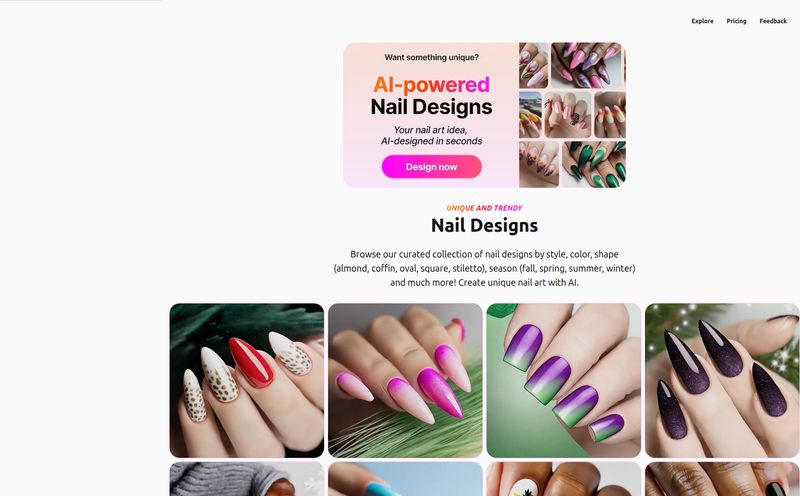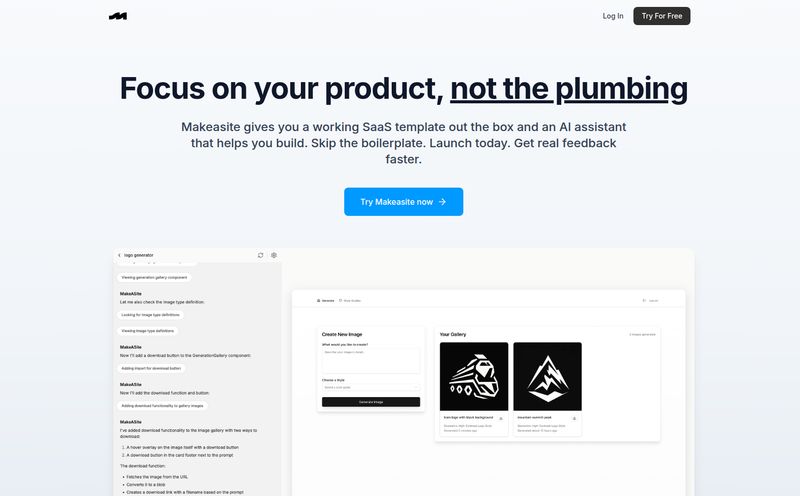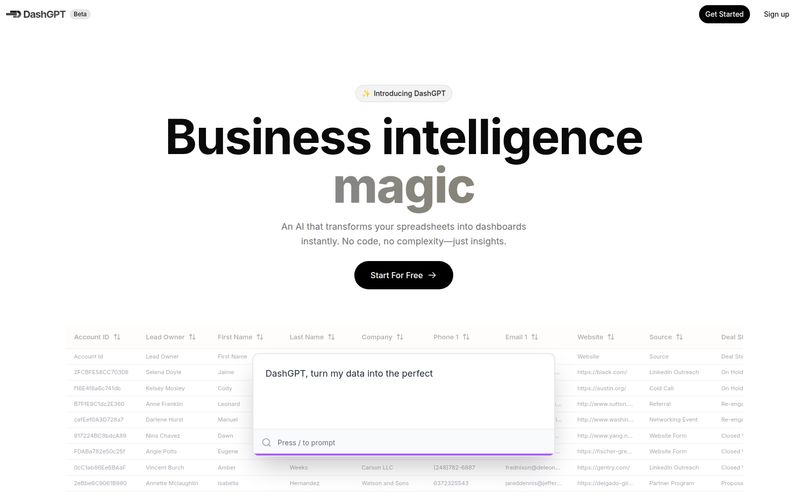I remember the old days. If you wanted a custom skin in a game, you had two options: pray the developers released one you liked, or fire up some god-awful, arcane piece of software to try and edit a texture file yourself. I once spent an entire weekend trying to put my favorite band's logo on a character's t-shirt in a PC game. The result? A pixelated, stretched-out mess that looked more like a modern art disaster than a cool outfit. It was painful.
So, when I hear about a new platform that promises to make 3D clothing design easy, my inner skeptic, honed by years of SEO and tech hype, raises a very prominent eyebrow. But every now and then, something comes along that actually feels… different. Enter Customuse.
On the surface, it's a platform for creating custom 3D clothing for games and apps. But dig a little deeper, and it feels like a glimpse into the future of user-generated content (UGC) and the creator economy. Is it all hype, or is it a genuinely useful tool for gamers, streamers, and aspiring designers? Let's get into it.
So, What Exactly is Customuse? (And Why Should You Care?)
Think of it like this: if Blender or Maya are the professional, intimidating photo studios with a million complex lights and lenses, Customuse is like having a top-tier smartphone camera with a killer portrait mode. It's designed to get you a fantastic result without needing a degree in 3D modeling. It’s a playground for creating 3D models, game assets, and even AR lenses, built on a foundation of templates and AI assistance.
This matters because the demand for personalization in digital spaces is exploding. We’re not just playing games anymore; we’re living in them. We build communities in Roblox, attend concerts in Fortnite, and express our identities through our avatars. Being able to create your own look isn’t just a nice-to-have, it’s becoming a core part of the experience. Customuse is trying to give the power to create that look to everyone, not just the people who know what a “UV map” is.

Visit Customuse
A Look at The Core Features
Alright, let's pop the hood and see what this thing is really running on. It’s not just one single trick; it's a combination of tools that work together.
The AI-Powered Design Assistant
This is the shiny feature that gets all the attention. The idea of typing a prompt like “a cyberpunk jacket with neon blue glowing wires” and getting a usable 3D texture is, frankly, incredible. We've all seen AI image generators, but one trained specifically for clothing patterns and textures? That's interesting. It’s not about generating a whole new piece of clothing from scratch (the 3D models are templates), but about creating the look. The fabric, the pattern, the soul of the garment. It’s a powerful brainstorming partner, even if the results sometimes need a human touch to be perfect.
Templates for a Running Start
This is the platform's bread and butter. You start with a pre-made 3D model—a hoodie, a pair of jeans, a dress—and you customize it. This is a double-edged sword, and we'll talk more about that in a bit. On one hand, it’s beautifully simple. It removes the single biggest barrier to 3D creation: actually making the 3D model. You can focus entirely on the fun part: the design. It's the difference between trying to build a car from raw steel and simply choosing your paint job, rims, and interior. One is a career, the other is a fun afternoon.
Beyond Skins: AR Lenses and Game Assets
This is where I think Customuse shows its true ambition. It’s not just about making your Roblox character look cool. The ability to design AR lenses means you could create a custom filter for your TikTok or Instagram followers. Imagine a streamer creating a branded helmet as an AR filter for their community to use. That's smart. And the “Game Asset” feature points to a future where indie developers could potentially use this to quickly create clothing for characters in their own projects. It’s a stepping stone from personal expression to practical application.
The Good, The Bad, and The... Complicated
No tool is perfect. As an SEO and a content guy, I live in a world of trade-offs. Customuse is no different. Let's break down what I love, and what gives me pause.
The Advantages of Customuse
The accessibility is just fantastic. Having free tools and being able to hop between your desktop and mobile phone to tweak a design is a game-changer. It means you can have an idea on the bus and start mocking it up right there. This lowers the barrier to entry to practically zero. Then there’s the community. A platform like this lives or dies by its users, and having a large community of creators means endless inspiration, helpful advice when you're stuck, and a built-in audience for your work. This ties directly into the potential for monetization. While the platform is young, the framework for a creator marketplace is clearly there. The idea of selling your unique designs to other players is a powerful motivator.
The Potential Downsides
Okay, let's address the elephant in the room: the template trap. Some will argue that if you’re only designing on a pre-made model, you’re not really a 3D artist. And, you know what? They have a point. It can lead to a sea of designs that feel a bit... samey. It’s a potential creativity ceiling. Secondly, while the basics are easy, I'm told the more complex features can have a bit of a learning curve. That’s to be expected, but it's worth knowing that you might need to put in some time to master everything. And then there's the big one, the real monster under the bed: copyright.
Copyright and IP: The Digital Wild West
The phrase “Copyright restrictions apply” is doing a lot of heavy lifting. In the age of AI, the question of ownership is a legal minefield. If an AI helps you design a texture, who owns it? You? Customuse? The void? It’s a question the courts are still wrestling with, as seen in major lawsuits like the one Getty Images filed against Stability AI. When you create something on Customuse, you need to be crystal clear on what you can and can’t do with it, especially if you plan to monetize. Can you use a brand's logo? Almost certainly not without permission. It’s an area that requires caution.
Who is Customuse Really For?
I see a few key groups who could get a lot out of this platform:
- The Casual Gamer: Someone who just wants a unique hoodie for their avatar that none of their friends have. For them, this tool is perfect. Quick, easy, and fun.
- The Aspiring Creator: This is the person who's always been curious about design but was scared off by complex software. Customuse is their sandbox. A place to experiment, build a portfolio, and get a feel for the process.
- The Streamer or Influencer: This is a massive opportunity. Creating on-brand digital merch for your community? Designing AR filters for them to use in their own content? It’s a fantastic way to boost engagement and build a stronger brand identity.
- The Indie Game Developer: While it won't replace a dedicated artist, it could be an amazing tool for prototyping. Need some quick placeholder outfits for your characters to test a new game mechanic? This could save you hours or even days.
Let's Talk Money: The Customuse Pricing
As of my writing this, Customuse doesn't have a big, flashy pricing page with three tiers. The focus is heavily on the “Free tools available” aspect. In my experience, this usually points to a 'freemium' model. You'll likely get a very generous free tier that lets you do most of the core stuff. Then, I'd wager there will be (or already are) premium options that might offer things like: higher resolution exports, more advanced tools, the ability to upload your own 3D models, or a more favorable revenue share on marketplace sales. It's a proven model that works well for creative platforms.
My Final Verdict on Customuse
So, is Customuse worth your time? Yes, absolutely.
But you have to know what it is, and what it isn't. It is not going to replace Blender. It will not turn you into a senior 3D artist at a AAA game studio overnight. It's not supposed to.
What it is, is a brilliant and much-needed bridge. It connects the desire for personal expression with the technical world of 3D design. It’s a gateway drug for creativity. It lets you get your hands dirty and see results instantly, which is incredibly motivating. The social and community aspects are the secret sauce that could give it real staying power. It's one of the first platforms I've seen that truly gets that the future of game content isn't just about what developers make, but about what players make. And that’s an exciting future to be a part of.
Frequently Asked Questions
- Is Customuse free to use?
- Yes, Customuse offers a robust set of free tools to get you started. There may be premium features or subscriptions for more advanced users, which is common for this type of platform.
- Can I sell the designs I make on Customuse?
- The platform is built with monetization opportunities in mind, allowing creators to potentially sell their designs within the Customuse ecosystem or supported games. Always check the terms of service regarding commercial rights.
- Do I need 3D modeling experience to use Customuse?
- Not at all. The platform is designed for beginners, using a template-based system so you can focus on the visual design without needing any technical 3D modeling skills.
- What games does Customuse support?
- Customuse is primarily focused on creating assets for popular UGC-friendly platforms like Roblox and Zepeto, but they are always expanding. It also allows creation for social apps via AR lenses.
- Who owns the copyright for designs made with Customuse AI?
- This is a complex and evolving area of law. Generally, you have rights to your final creation, but you should carefully read the Customuse terms of service to understand the specifics of ownership, especially concerning AI-generated content and commercial use.
- Is Customuse available on mobile devices?
- Yes, one of the great features of Customuse is its accessibility. You can design on both desktop and mobile, allowing for creativity on the go.
Reference and Sources
- The official Customuse website: www.customuse.com
- The Verge: "Getty Images is suing the creators of AI art tool Stable Diffusion" - https://www.theverge.com/2023/2/6/23587393/ai-art-getty-images-stability-stable-diffusion-lawsuit
- Roblox Creator Hub: An example of a thriving UGC economy - https://create.roblox.com/



